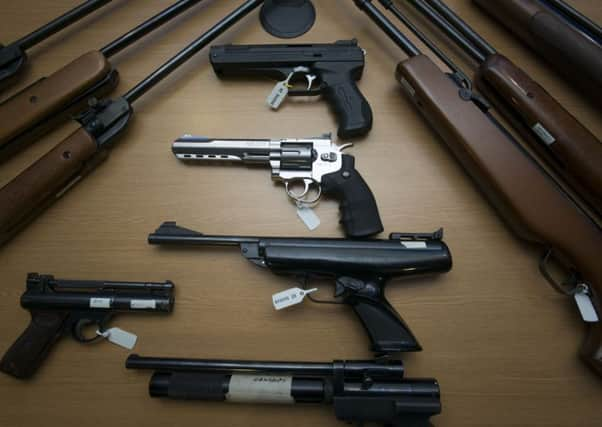Leaders: Licensing of airguns is no panacea but is still right


The airgun amnesty has only been in operation for just over a week, and already 2,300 weapons have been handed to Police Scotland by those who do not want to have to obtain a licence for their firearm under new legislation.
The figure is a drop in the ocean when set against the estimated half a million airguns believed to be in circulation in Scotland, and with the amnesty window only open until 12 June, the number of weapons surrendered may not break 10,000.
Advertisement
Hide AdAdvertisement
Hide AdBut the amnesty also plays an important role in publicising the new controls, and in forcing us to consider the dangers that airguns can pose.
If there was any doubt about the justification behind introducing a licensing scheme, a glance at recent statistics should put the matter to rest. Airguns were used in 182 crimes in 2013-14, which represents about half of all firearms offences that year.
We think of gun crime as the domain of shotguns and rifles, lethal devices which will take a life if mis-used, while our attitude to airguns is softer – that they can cause injury, but are unlikely to kill. The hard fact, however, is that an airgun can cause death if used irresponsibly and with malice.
The weapon’s appearance is also an issue. To the lay person with little or no knowledge of guns, a top-of-the-range airgun has the appearance of a deadly rifle, and in all probability the gun will have been designed to give that impression. It is little comfort to be told by the owner that a weapon is “only an airgun” if the weapon looks like it could be used by a firing squad.
In addition, the availability of such weapons can cause distress. While airguns cannot be sold to anyone under the age of 18, they are startling sights when on display anywhere from petrol stations to specialist toy shops, where children can be tempted by toy guns at the same time. And the more realistic a weapon looks – whether genuine or replica – the better, as far as children are concerned.
But there is a legitimate purpose for airguns, if used properly, including controlling pests such as vermin or rabbits. They are also used in the recognised sport of target shooting, and Scotland has a history of success at the Commonwealth Games in airgun events.
The question is not about whether to allow airguns, but how to control them. The introduction of licensing should help ensure that, like the shotgun licence holder, the airgun owner is a fit and proper person, and can demonstrate good reason for applying for a certificate.
The scheme should not be cumbersome, and the paperwork would benefit from being a reasonable assessment of a person’s circumstances rather than the equivalent of a 50-page mortgage application.
Advertisement
Hide AdAdvertisement
Hide AdA licence scheme is not the answer to all problems – if it was, there would be no gun crime – but if the airgun scheme can help reduce the odds of the kind of tragedy that saw a man convicted of murder in 2005 over the shooting of Glasgow toddler Andrew Morton, it will be worth it.
Retaking Fallujah is not without risk
The city of Fallujah is one of the most battle-scarred in the world. In 2004 it was the scene of major battles as US forces moved in to regain control. It has been reported that 36,000 of the city’s 50,000 homes were destroyed, along with 60 schools and 65 mosques and shrines in that fighting.
The Sunni city was in rebellion against the Iraqi central government when it was taken by Islamic State in 2014 and, second only to Mosul, it is a prestigious stronghold for the murderous regime. Of the 300,000 people e in the city before, it is now estimated that there are 50,000 civilians inside the devastated city. There have been reports of civilians starving. The city has been under almost constant bombardment for the last two years.
It now appears that Iraqi forces are in the final stages of retaking the city. That, when it comes, will be a major blow to Islamic State and a huge step in the long war aimed at eradicating IS.
But care needs to be taken in the manner of retaking the city. It is thought that most IS fighters are from Fallujah, so they are literally fighting for their homes and families and will probably fight to the last bullet. Just how much it will take out of the Iraqi forces, even although they have their elite squads involved here, will be key to what happens next.
The forces involved in the storming of Fallujah include Iranian-backed Shia militias. It is imperative that these militias are kept out of the centre of the fighting and there are no repeat of anti-Sunni sectarian reprisals as there have been in the past.
After Fallujah the greatest fight of all will be for Mosul, and that could be made much harder if it is seen as the last stand in a sectarian war to the death.